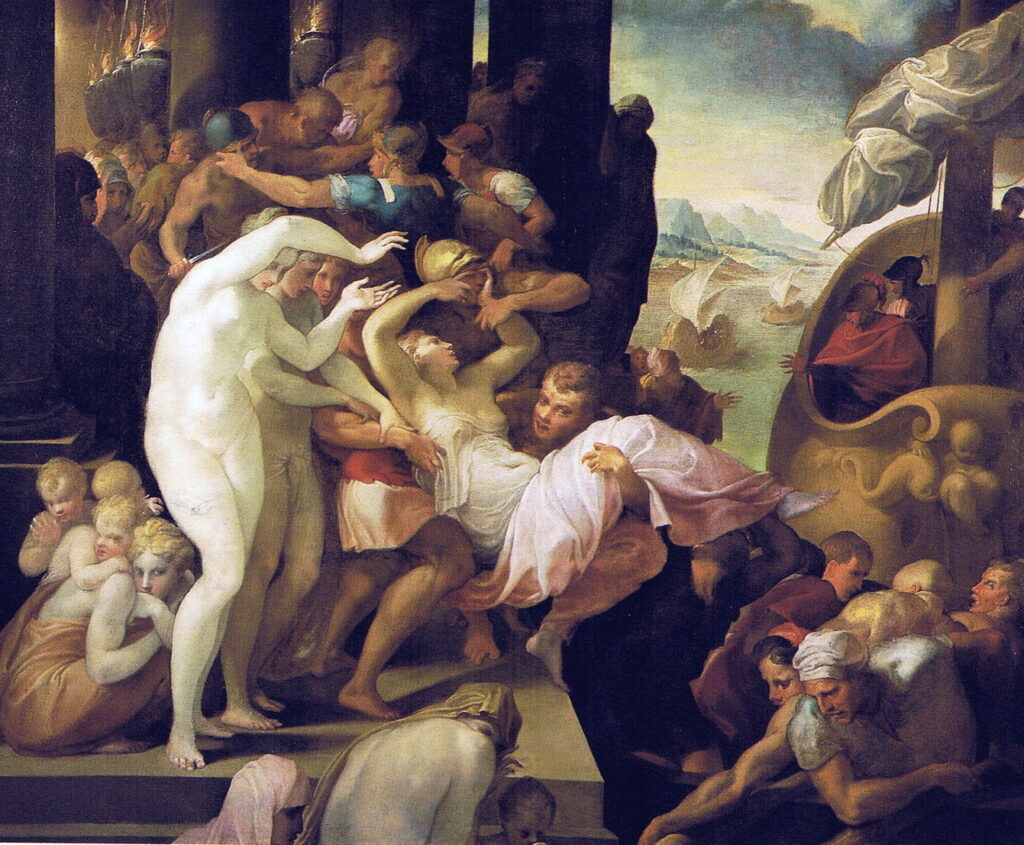Helen of Troy: victim or villain? 1

Helen was one of the most prominent women in classical legends of the Mediterranean civilisations. Daughter of the King of Sparta, she was abducted by Theseus when still a child, rescued by her twin brothers, married to an unrelated successor King of Sparta, abducted by Paris, Prince of Troy, and the immediate cause of the Trojan War. Universally recognised as the most beautiful woman in the Mediterranean civilisations, hers was the face that launched a thousand ships and inspired the legends of the Epic (Trojan) Cycle. This weekend I ask whether she was the victim of gods and men, or the villain of the piece.
Her origins remain disputed. Later Roman accounts, the basis of most more recent paintings, claim she was the outcome of the union of Leda, wife of Tyndareus, King of Sparta, with Zeus, in the form of a swan. Those dating back to the time of the Cypria and the Epic Cycle are more complex, and make Helen’s mother Nemesis, the personification of public disapproval.
In the Greek version, Zeus appeared to Leda as a swan. Both he and Tyndareus impregnated Leda at about the same time, but as Zeus was then in the form of a swan, her twin pregnancies resulted in two eggs: one hatched into Castor, who was human because his father was Tyndareus; the other hatched into Polydeuces (Latin Pollux), who was divine as his father was Zeus. Despite their different fathers, the twins were known as the Dioskuroi, who were later to rescue Helen.
In the older accounts, when Nemesis was being pursued by Zeus, she tried shape-shifting to avoid being raped. When she changed into a goose, Zeus became a gander and she succumbed. Being a goose at the time, she too laid an egg, and that was found and taken to Leda to care for and presumably incubate with those of the Dioskuroi. By that account Leda was Helen’s foster mother.
Unknown follower of Leonardo da Vinci (1452–1519), Leda and the Swan (early 1500s), oil on panel, 131.1 × 76.2 cm, Philadelphia Museum of Art, Philadelphia, PA. Wikimedia Commons.
This interpreted copy of Leonardo da Vinci’s Leda and the Swan, probably painted in the early 1500s and now in the Philadelphia Museum of Art, summarises the later account of Helen’s unique birth, with two eggs and a fourth baby, Clytemnestra. Later paintings, perhaps wisely, concentrated on Leda and Zeus, and skipped the incredible egg phase altogether.
Jacopo Tintoretto (c 1518-1594), Leda and the Swan (E&I 221) (c 1578-83), oil on canvas, 167 x 221 cm, Galleria degli Uffizi, Florence, Italy. Wikimedia Commons.
Tintoretto and his workshop painted Leda and the Swan in about 1578-83, and wittily include two caged birds, a duck and what appears to be a parrot, with a cat taunting the duck.
Gustave Moreau (1826–1898), Leda (1865-75), oil on canvas, dimensions not known, Musée National Gustave-Moreau, Paris. Wikimedia Commons.
Gustave Moreau started his early Leda in 1865 but abandoned it incomplete in 1875.
Gustave Moreau (1826–1898), Leda and the Swan (c 1882), watercolor and gouache on paper, 34.2 × 22.2 cm, Private collection. Wikimedia Commons.
Moreau’s later watercolour of Leda and the Swan (c 1882) revisits this myth as another static display of female beauty, with the added twist of a large, dark aquiline bird by Leda’s feet. Although this could be an eagle, the bright red at its base suggests the flames of a phoenix just starting to self-combust. This is a curious combination of symbols of self-renewal through cyclical combustion, and a woman who laid eggs.
Joseph Stella (1877–1946), Leda and the Swan (1922), oil on copper, 108 x 118.1 cm, Private collection. The Athenaeum.
Joseph Stella’s Leda and the Swan (1922) also follows that more modern tradition.
According to most accounts, the under-age Helen was abducted by Theseus, the ‘hero’ who abandoned Ariadne on the island of Naxos. Helen’s adopted brothers the Dioskuroi were unimpressed by this, so they paid Theseus a visit, and persuaded him to return their step-sister. In return for her son’s offence, Aethra, mother of Theseus, was made Helen’s slave, and wasn’t freed until after the fall of Troy decades later.
Léon Cogniet (1794–1880), Helen Delivered by Castor and Pollux (1817), oil on canvas, dimensions not known, École Nationale Supérieure des Beaux-Arts, Paris. By VladoubidoOo, via Wikimedia Commons.
Léon Cogniet’s entry for the Prix de Rome in 1817, Helen Delivered by Castor and Pollux, was deemed the winner, and established his career as a major narrative painter.
Jean-Bruno Gassies (1786–1832), Castor and Pollux rescuing Helen (1817), oil on canvas, 113.2 x 145.4 cm, location not known. Wikimedia Commons.
One of the better runners-up that year was Jean-Bruno Gassies’ Castor and Pollux Rescuing Helen. The woman being escorted away at the left may have been intended to be Theseus’ mother Aethra, although she appears remarkably young.
Helen’s beauty only grew over time, and her hand was sought by many suitors in a contest organised by the Dioskuroi. Among them were many prominent figures, including Odysseus. Helen’s father, King Tyndareus, feared that in choosing between her suitors he would offend and cause trouble. The suitors therefore agreed to swear an oath, under which they would all defend the successful suitor in the event that anyone should quarrel with them, the crucial Oath of Tyndareus. Under that, Menelaos, King of Sparta, was chosen as Helen’s husband, and the couple later had a daughter, Hermione, and possibly sons.
None of them knew, though, of Zeus’s plan to tip the world into war by setting the Mycenaean Greeks against the city-state of Troy. Central to that was a beauty contest between three goddesses, ending in its judge, Paris Prince of Troy, being bribed by Aphrodite with marriage to Helen, the most beautiful woman in the world.
To assist Paris in obtaining this bribe, Aphrodite took him back to the forests on Mount Ida, where craftsmen built ships to carry Paris and Aphrodite’s son Aeneas to Greece. During this, prophetic warnings were given by Helenos and Cassandra telling of the fateful outcome for both Paris and the city of Troy. Despite those warnings, Paris sailed his ships to Gythion in Greece, where he disembarked and made his way to Sparta.
For nine days, Menelaos entertained Paris as a guest, while Paris plied his wife Helen with secret gifts. On the tenth day, the king was called away to Crete for his grandfather’s funeral. He left his house in Helen’s charge, reminding her to ensure their guests were well cared-for, although clearly not in the way that Paris was intending.
Given its importance to subsequent events and the whole of the Epic Cycle, you might have expected clarity over how Helen and Paris became partners. Instead, there are multiple and conflicting accounts leaving everything in doubt.
Francesco Primaticcio (1504–1570), The Rape of Helen (c 1530-39), oil on canvas, 155 × 188 cm, Bowes Museum, Barnard Castle, England. Wikimedia Commons.
Most of the early paintings, such as Primaticcio’s The Rape of Helen from about 1530-39, show Paris abducting Helen against her will. Here a youthful Paris is carrying her from the city of Sparta into one of his ships, ready to sail off to Troy with his prize.
Maerten van Heemskerck (1498-1574), Panorama with the Abduction of Helen Amidst the Wonders of the Ancient World (1535), oil on canvas, 147.3 x 383.5 cm, Walters Art Museum, Baltimore, MD. Wikimedia Commons.
Maerten van Heemskerck’s magnificent Panorama with the Abduction of Helen Amidst the Wonders of the Ancient World (1535) puts the same story into a world-view panorama including classical ‘wonders’ such as the Colossus of Rhodes. Helen is here part of a small raid on Sparta which also took other prizes.
Tintoretto (1519–1594), The Rape of Helen (1580), oil on canvas, 186 x 307 cm, Museo Nacional del Prado, Madrid, Spain. Wikimedia Commons.
For Tintoretto, The Rape of Helen (1580) was nothing short of war. As an archer is about to shoot his arrow, and another Trojan fends off attackers with a pike, Helen, dressed in her finery, is manhandled onto Paris’s ship like a stolen statue.
Later paintings, as I’ll show in tomorrow’s sequel, come to depict this as a seduction rather than abduction.
Reference
Wikipedia’s lengthy and well-referenced article about Helen.




